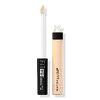What's inside
What's inside
 Key Ingredients
Key Ingredients

 Benefits
Benefits

 Concerns
Concerns

 Ingredients Side-by-side
Ingredients Side-by-side

Water
Skin ConditioningIsododecane
EmollientCyclopentasiloxane
EmollientCetyl PEG/PPG-10/1 Dimethicone
EmulsifyingTrimethylsiloxysilicate
EmollientIsononyl Isononanoate
EmollientCyclohexasiloxane
EmollientGlycerin
HumectantVp/Hexadecene Copolymer
Tridecyl Trimellitate
EmollientPropylene Glycol
HumectantSodium Chloride
MaskingPhenoxyethanol
PreservativeQuaternium-18 Bentonite
Magnesium Stearate
Cosmetic ColorantVinyl Dimethicone/Methicone Silsesquioxane Crosspolymer
Mica
Cosmetic ColorantSorbitan Sesquioleate
EmulsifyingPolyglyceryl-3 Diisostearate
EmulsifyingMethicone
EmollientTribehenin
EmollientParfum
MaskingEthylhexylglycerin
Skin ConditioningTriethoxycaprylylsilane
Glutathione
Acetyl Tetrapeptide-3
Skin ProtectingZinc PCA
HumectantTocopheryl Acetate
AntioxidantCaesalpinia Spinosa Fruit Extract
Skin ProtectingCeramide NP
Skin Conditioning2,3-Butanediol
HumectantButylene Glycol
HumectantOpuntia Ficus-Indica Flower Extract
Skin ConditioningKappaphycus Alvarezii Extract
Skin Conditioning1,2-Hexanediol
Skin ConditioningHydrogenated Lecithin
EmulsifyingCamellia Japonica Flower Extract
EmollientNiacinamide
SmoothingHamamelis Virginiana Extract
AntiseborrhoeicDimethyl Isosorbide
SolventGlyceryl Stearate
EmollientPolysorbate 20
EmulsifyingCeramide Ns
Skin ConditioningCeramide As
Skin ConditioningCeramide AP
Skin ConditioningCholesterol
EmollientResveratrol
AntioxidantHydroxyacetophenone
AntioxidantOligopeptide-1
Skin ConditioningDecapeptide-4
Skin ConditioningPalmitoyl Tripeptide-1
Skin ConditioningPalmitoyl Tetrapeptide-7
Skin ConditioningCeramide EOP
Skin ConditioningCI 77891
Cosmetic ColorantCI 77492
Cosmetic ColorantCI 77491
Cosmetic ColorantCI 77499
Cosmetic ColorantWater, Isododecane, Cyclopentasiloxane, Cetyl PEG/PPG-10/1 Dimethicone, Trimethylsiloxysilicate, Isononyl Isononanoate, Cyclohexasiloxane, Glycerin, Vp/Hexadecene Copolymer, Tridecyl Trimellitate, Propylene Glycol, Sodium Chloride, Phenoxyethanol, Quaternium-18 Bentonite, Magnesium Stearate, Vinyl Dimethicone/Methicone Silsesquioxane Crosspolymer, Mica, Sorbitan Sesquioleate, Polyglyceryl-3 Diisostearate, Methicone, Tribehenin, Parfum, Ethylhexylglycerin, Triethoxycaprylylsilane, Glutathione, Acetyl Tetrapeptide-3, Zinc PCA, Tocopheryl Acetate, Caesalpinia Spinosa Fruit Extract, Ceramide NP, 2,3-Butanediol, Butylene Glycol, Opuntia Ficus-Indica Flower Extract, Kappaphycus Alvarezii Extract, 1,2-Hexanediol, Hydrogenated Lecithin, Camellia Japonica Flower Extract, Niacinamide, Hamamelis Virginiana Extract, Dimethyl Isosorbide, Glyceryl Stearate, Polysorbate 20, Ceramide Ns, Ceramide As, Ceramide AP, Cholesterol, Resveratrol, Hydroxyacetophenone, Oligopeptide-1, Decapeptide-4, Palmitoyl Tripeptide-1, Palmitoyl Tetrapeptide-7, Ceramide EOP, CI 77891, CI 77492, CI 77491, CI 77499
Water
Skin ConditioningCyclopentasiloxane
EmollientHydrogenated Polyisobutene
EmollientGlycerin
HumectantSorbitan Isostearate
EmulsifyingPropylene Glycol
HumectantTitanium Dioxide
Cosmetic ColorantOzokerite
Emulsion StabilisingPhenoxyethanol
PreservativeMagnesium Sulfate
Disteardimonium Hectorite
StabilisingDisodium Stearoyl Glutamate
CleansingMethylparaben
PreservativeAcrylates Crosspolymer
AbsorbentAlumina
AbrasiveButylparaben
MaskingAluminum Hydroxide
EmollientTocopherol
AntioxidantSilica
AbrasiveChamomilla Recutita Extract
Skin ConditioningCI 77891
Cosmetic ColorantIron Oxides
Mica
Cosmetic ColorantWater, Cyclopentasiloxane, Hydrogenated Polyisobutene, Glycerin, Sorbitan Isostearate, Propylene Glycol, Titanium Dioxide, Ozokerite, Phenoxyethanol, Magnesium Sulfate, Disteardimonium Hectorite, Disodium Stearoyl Glutamate, Methylparaben, Acrylates Crosspolymer, Alumina, Butylparaben, Aluminum Hydroxide, Tocopherol, Silica, Chamomilla Recutita Extract, CI 77891, Iron Oxides, Mica
 Reviews
Reviews

Ingredients Explained
These ingredients are found in both products.
Ingredients higher up in an ingredient list are typically present in a larger amount.
Ci 77891 is a white pigment from Titanium dioxide. It is naturally found in minerals such as rutile and ilmenite.
It's main function is to add a white color to cosmetics. It can also be mixed with other colors to create different shades.
Ci 77891 is commonly found in sunscreens due to its ability to block UV rays.
Learn more about CI 77891Cyclopentasiloxane, or D5, is a silicone used to improve texture of products and trap moisture.
D5 is considered lightweight and volatile. Volatile means it evaporates quickly after application. Once evaporated, D5 leaves a thin barrier that helps keep skin hydrated.
It is also an emollient. Emollients help soften the skin and prevent water loss. Silicones create a silky texture in products. D5 helps other ingredients become more spreadable.
Studies show D5 is safe to use in skincare products. We recommend speaking with a skincare professional if you have concerns.
Learn more about CyclopentasiloxaneGlycerin is already naturally found in your skin. It helps moisturize and protect your skin.
A study from 2016 found glycerin to be more effective as a humectant than AHAs and hyaluronic acid.
As a humectant, it helps the skin stay hydrated by pulling moisture to your skin. The low molecular weight of glycerin allows it to pull moisture into the deeper layers of your skin.
Hydrated skin improves your skin barrier; Your skin barrier helps protect against irritants and bacteria.
Glycerin has also been found to have antimicrobial and antiviral properties. Due to these properties, glycerin is often used in wound and burn treatments.
In cosmetics, glycerin is usually derived from plants such as soybean or palm. However, it can also be sourced from animals, such as tallow or animal fat.
This ingredient is organic, colorless, odorless, and non-toxic.
Glycerin is the name for this ingredient in American English. British English uses Glycerol/Glycerine.
Learn more about GlycerinMica is a naturally occurring mineral used to add shimmer and color in cosmetics. It can also help improve the texture of a product or give it an opaque, white/silver color.
Serecite is the name for very fine but ragged grains of mica.
This ingredient is often coated with metal oxides like titanium dioxide. Trace amounts of heavy metals may be found in mica, but these metals are not harmful in our personal products.
Mica has been used since prehistoric times throughout the world. Ancient Egyptian, Indian, Greek, Roman, Aztec, and Chinese civilizations have used mica.
Learn more about MicaPhenoxyethanol is a preservative that has germicide, antimicrobial, and aromatic properties. Studies show that phenoxyethanol can prevent microbial growth. By itself, it has a scent that is similar to that of a rose.
It's often used in formulations along with Caprylyl Glycol to preserve the shelf life of products.
Propylene Glycol is an odorless, colorless liquid. As a humectant, it helps skin retain moisture. It also aids in delivering active ingredients.
Another role of this ingredient is preventing a product from melting or freezing. Propylene glycol also adds antimicrobrial properties to a product, elongating product lifespan.
This ingredient is considered an organic alcohol and commonly added into both cosmetics and foods.
Those with sensitive skin or conditions may develop a rash when using this ingredient.
Learn more about Propylene GlycolWater. It's the most common cosmetic ingredient of all. You'll usually see it at the top of ingredient lists, meaning that it makes up the largest part of the product.
So why is it so popular? Water most often acts as a solvent - this means that it helps dissolve other ingredients into the formulation.
You'll also recognize water as that liquid we all need to stay alive. If you see this, drink a glass of water. Stay hydrated!
Learn more about Water